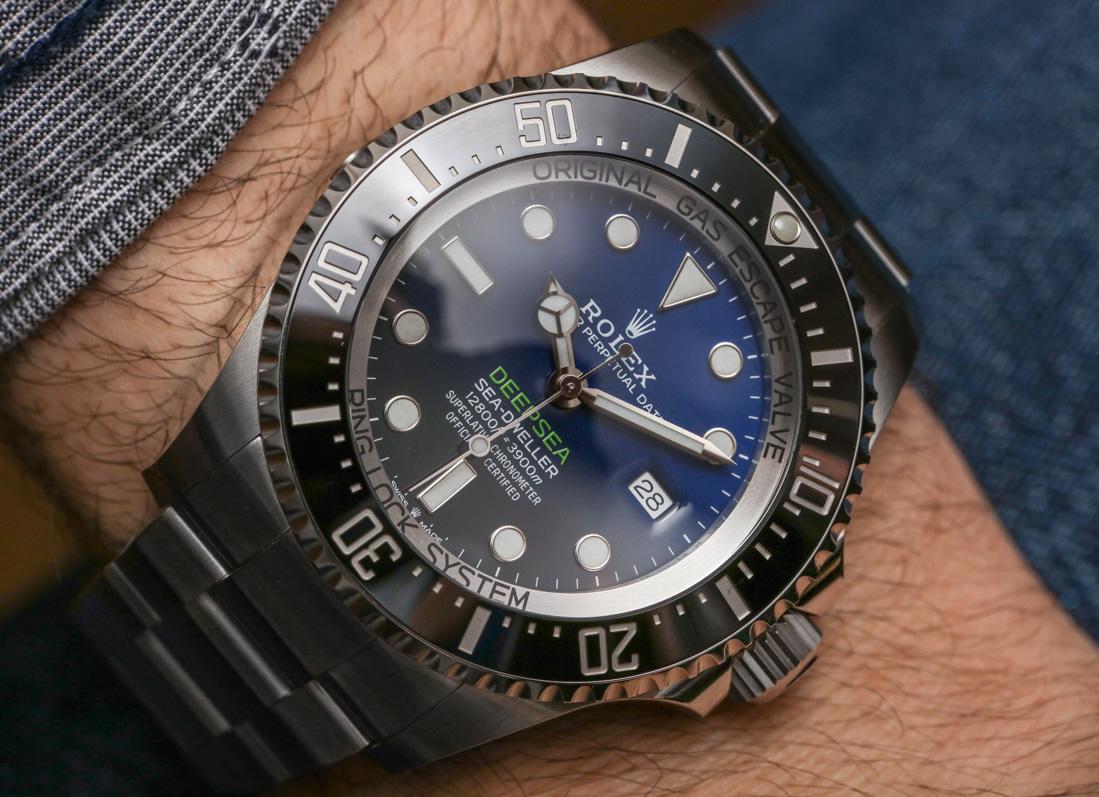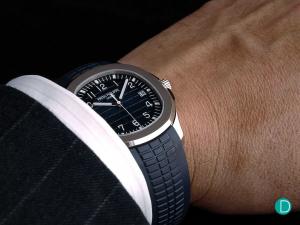Rolex Deepsea Sea-Dweller D-Blue Watch: A Review

Rolex has always been known for producing excellent dive watches. The Submariner, for instance, is one of the most popular timepieces around. But it is important to note that Rolex’s arsenal is more than just the Submariner. People often forget its shy but capable sibling — the Rolex Deepsea Sea-Dweller.
Lucky for us, we got our hands on one of these grails. So, for this review, we’ll tackle the Rolex Deepsea Sea-Dweller D-Blue Dial. We’ll talk about its history and a few fun facts about the watch. Also, we’ll see how well it fares deep into the ocean.
History of the Rolex Deepsea Sea-Dweller
Being an Explorer is in the Genes
To start, Rolex has always been a companion of scientists who traverse the extreme parts of the world. In fact, it was the brand’s main selling point. One of their vintage ads even says: “If you were looking for a lost empire here tomorrow, you’d wear a Rolex”. And if you would look at their catalogue, you’d know that it’s true. Among those watches made for adventures are the Explorer, Yacht Master, and Submariner.
With that said, Rolex invented the Deepsea Sea-Dweller with one purpose in mind. And that is to outperform themselves. It’s said that if you want to master your craft, it’s always a good idea to have a healthy competition with yourself, right? So, the Swiss brand went ahead and developed something that would challenge their reigning dive watch.

10,916 Metres Underwater
On January 23, 1960, two people made history. Swiss oceanographer Jacques Piccard and U.S. Navy Lieutenant Don Walsh both descended the deepest-known place in the ocean — the Marianas Trench. And of course, an experimental Rolex Deepsea Special wristwatch was attached to the bathyscaphe that they used to descend.
Fortunately, the watch withstood the pressure even as they reached the bottom of the trench, which is 10,916 meters deep. To emphasise how impressive that is, no submersible had survived that amount of pressure prior to the challenge.
Another person who took on the Rolex Deepsea challenge was writer, director, and explorer James Cameron. With his submersible craft called the Deepsea Challenger, he conquered the bottom part of the Marianas Trench at a depth of 10,908 meters. It is said that the watch used in the expedition can withstand a pressure of up to 15,000 meters.

Commercially-Produced Deepsea Sea-Dweller
Unfortunately, the watches used in the previous anecdotes were of a special kind and were not commercially produced. In the case of the first expedition, the watch is inappropriate in a casual setting as the watch is 35mm thick. Take note that we’re talking about the height and not the diameter. Apart from that, they would be extremely expensive if released.
Nevertheless, the DNA of these timepieces became the blueprint of the commercially-produced Rolex Deepsea Sea-Dweller models.

The Rolex Deepsea Sea-Dweller D-Blue Dial
In 2014, Rolex released a special version of the Deepsea Sea-Dweller in honour of Cameron’s deep dive. Instead of the usual black dial, it came in what they call the “D-Blue” dial. This is the specific model that we’re going to review in a while.
Now that we have the lowdown on the Rolex Deepsea Dweller’s roots, let’s take a look at its performance.
First Impression
In all honesty, the timepiece is nearly identical to its more popular sibling — the Rolex Submariner. It has the same uni-directional bezel, Oystersteel bracelet, and round hour markers. However, there are a few details that separate it from the Sub.
Such differences are the thickness and the heft, which you will notice as soon as you hold it. As far as first impressions go, the watch looks solidly built. But how does it fare in real-life conditions? So, let’s see the important numbers of the watch by reviewing the specifications below.
The Deepsea Sea-Dweller D-Blue’s Specs
Here are some of the important details that you should know about the watch:
- Case material: Stainless steel
- Movement: Automatic
- Jewels: 31
- Frequency:28800bph
- Dimensions: 44mm
- Power reserve: 70 hours
- Water resistance: 3,900m
The first word you’ll think of after looking at the specs sheet is “wow”. In particular, the power reserve and water-resistance are way above average. But are these numbers as good on paper as they are in practice? Let’s find out below.

1. CASE
One of the most important things for a high-pressure-resistant watch is the case. Basically, this is what protects the gears inside from the harsh elements. Based on theories in watchmaking, the thickness of the case is directly proportional to its water-resistance, which explains why the Sea Dwellers used in the challenges were extremely thick.
-
The Ringlock System
However, one would not dare to use those watches as a daily driver due to the thickness. To answer the problem, Rolex redesigned the case structure and called it the Ringlock System. With this system, three elements absorb the pressure. These are the sapphire crystal (5.5mm thick), the case back made of Grade 5 titanium (3.28mm thick), and the inner ring made of Biodur 108 steel. In addition to that, the whole system is surrounded by 904L steel.
-
High-Quality Materials
As always, Rolex chose the materials with extreme care. To illustrate, the Biodur 108 steel is three times more tension-proof than the average case. Meanwhile, the Grade 5 titanium is four times more durable.

2. GAS ESCAPE VALVE
If you would observe the words printed on the Deepsea’s dial, you’ll see “gas escape valve” printed on it. The gas escape valve is one of Rolex’s most important inventions. In fact, this technology upped the game for dive watches.
To give you an overview, a lot of divers found the crystal of their watches popping off. This was due to the helium molecules that penetrate the watch’s case through the gaskets. While a diver is on the decompression stage, the gas fails to escape the watch’s case. Thus, causing the crystal to pop off the watch like a champagne cork.
As a solution to the problem, Rolex invented a one-way valve. It safely allows the gas trapped in the watch to escape at a given pressure while the diver is on the decompression process. All while preserving the waterproofness of the watch’s case.
3. BEZEL
Like any other dive watch, the Rolex Deepsea Sea-Dweller has a unidirectional bezel. It’s made with a high-tech ceramic track ring that’s resistant to scratches. This is extremely useful during extreme activities as you wouldn’t have to worry about destroying it. Both the numerals and indexes on the bezel are milled and coated with platinum.
Aside from that, the bezel can be adjusted in half-minute increments. Lastly, every turn of the bezel feels firm and precise. It’s a nice thing to have as it would make it easier for you to measure the time.
4. DIAL
As mentioned above, the Rolex Deepsea Sea-Dweller looks similar to the Submariner. Just cover the “Deepsea” printed on the dial and you’d have a hard time distinguishing one from the other. To a lot of people, this is a good thing because it sports a timeless and versatile design.
Another thing that’s interesting about the dial is that it isn’t completely blue. At the top, it gives off a navy blue hue. As it goes down, it gradually darkens until it becomes jet black at the bottom. This is a nod to how the ocean becomes darker as you go deeper.
Furthermore, the word “Deepsea” that’s printed on the dial comes in a neon green colour. It is the same colour as Cameron’s underwater craft. Coincidentally, the colour improves readability as it makes it easy for you to read the print in the dark.

5. LUME
One of the overlooked features of a dive watch is the lume. For serious divers, it is important to have a readable watch in dark conditions. Fortunately, the Rolex Deepsea Sea-Dweller can deliver.
The hour markers are large and applied with Chromalight lume. Unlike Rolex’s other models that glow green, this one gives off a light blue glow. According to the brand, it can last up to eight hours which is more than double the average time of luminescent materials.
Moreover, blue light is the preferred colour for lume. According to science, water absorbs long-wave light better than short-wave light. As a result, blue light is the easiest to see when you’re submerged in water.

6. MOVEMENT
As seen above, the case is durable enough to protect something precious inside. But what exactly is it protecting? It’s good to know that the calibre inside is as precious as the exterior. With that said, the Rolex Deepsea Sea-Dweller uses the Calibre 3235.
This movement is a refurbished version of the Calibre 3135. Among its improvements are resistance to impacts, accuracy, and precision. Apart from that, Rolex was able to increase its power reserve from the standard 48 to 70 hours. This is mainly due to the new ball-bearing oscillator.
In addition, the movement uses a thinner barrel wall which makes more room for a longer mainspring and Chronergy escapement. This modification makes the watch more efficient by 15%. It also produces a quieter ticking sound when it comes to the hands.
Aside from being water-resistant, the movement is also resistant to magnets. This is due to the LIGA (lithography, electroplating, and moulding) process of the nickel-phosphorus alloy escape wheel. Lastly, it has the Paraflex shock absorber, which can also be seen in other Rolex models.
7. ACCURACY
Accurate timekeeping is important in dive watches. And you’ll be delighted to hear that the movement used for this timepiece is certified by the Contrôle Officiel Suisse des Chronomètres (COSC), the official Swiss Chronometer Testing Institute.
As if that’s not enough, Rolex watchmakers regulate the movement to achieve an even better accuracy rate. With their own standards, the numbers should be between -2 and +2 seconds per day. Yes, do get used to the fact that Rolex loves exceeding expectations.

8. STRAP
We do not usually write a separate section for the strap of the watch. However, we feel that the Rolex Deepsea Sea-Dweller’s Oystersteel bracelet deserves one. Furthermore, in a diving session, wearing a comfortable watch is essential.
The metal strap has an Oyster style and is made of 904L steel. Rolex specifically used this material as it is more resistant to saltwater corrosion.
When it comes to comfort, Rolex redesigned the lugs for a better fit. The Oysterlock clasp setup includes both a Fliplock (wetsuit extension) and a Glidelock (a sliding in-clasp extension system). These upgrades allow the wearer to lengthen the bracelet mid-dive. Indeed, divers will appreciate the convenience since they have to readjust the bracelet when the temperature changes.
Pros and Cons of the Deepsea Sea-Dweller
Like any other watch, the Deepsea Sea-Dweller has its own strengths and weaknesses. Let’s check out what makes it good along with the things that it can improve on.
PROS:
- High water-resistance
This watch is undeniably one of the most ultra-resistant diver watches. With a water-resistance of 3,900m, only a few models surpass this level. It’s no wonder people call it the “watch that conquered the deep”.
- Legible even in dark conditions
As mentioned above, the hands and hour markers of this watch are applied with Chromalight. This makes it a valuable tool not only underwater but in everyday life. Need to check the time while watching the movies? Simply look at your wrist. It’s a guarantee that the lume will shine even after the credits have rolled.
- Extremely durable
Durability is the least of your problems when it comes to this watch. Rolex engineered it to become resistant to water pressure, magnets, shocks, and scratches. Even after years of regular use, your watch will likely feel new.
CONS:
- Thick case
At 17.7 mm, the Rolex Deepsea Dweller’s case can be a handful for some people. Especially for those who are used to the lightness of ultra-slim dress watches. However, do understand that this is the price for having a high water-resistance rating.
Furthermore, Rolex took steps in keeping its thickness in check. As mentioned above, they made use of the Ringlock System to make the watch wearable.
- Limited material options
Rolex is known for releasing models in different materials like yellow gold, white gold, etc. However, such is not the case for the Deepsea Sea-Dweller. As mentioned, the materials used were handpicked for optimum durability. Thus, limiting the user’s choice when it comes to colours.
This can be a big factor for people who want to have options when it comes to materials. But if you couldn’t care less about the colour of your watch as long as it’s durable, this is hardly a disadvantage.
Who is the Rolex Deepsea Sea-Dweller for?
Each watch fits a certain type of personality. And for the Deepsea Sea-Dweller, the obvious answer would be professional divers. Indeed, the features of the watch are more than enough for their needs.
However, there are good reasons why a non-diver will also appreciate this mechanical marvel. Firstly, this watch made history by reaching the bottom of the Marianas Trench. That reason alone is enough to spice up a completist’s watch collection.
Final Notes
Quoting from the brand itself, “No other watch is engineered like the Rolex Deepsea”. There is no denying that this watch is one of the most technologically advanced. Sure, there are a few drawbacks like the size and weight. However, if you would compare it to what the watch can do, the cons are understandable.
Whether you’re going to maximise the watch’s features or not, the Rolex Deepsea Sea-Dweller is a great buy and will always be a conversation starter.
If you came here for more dive watches, check out our list of Omega Seamaster Aqua Terra Watches!


